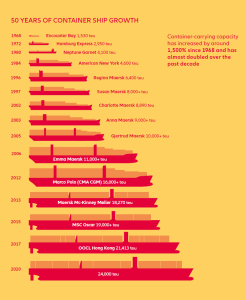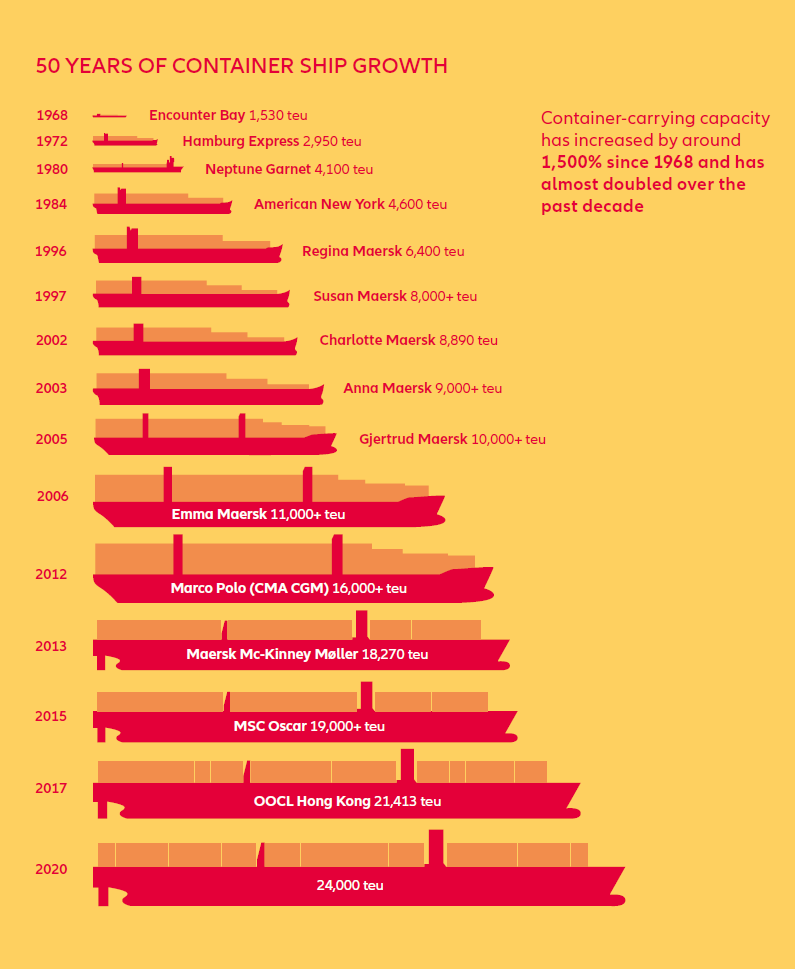🚢 Container Ship Safety in the Spotlight as Vessel Sizes Surge
In January 2015, the world witnessed a milestone in maritime engineering — the inauguration of the MSC Oscar, then the largest container ship ever built, capable of carrying 19,224 twenty-foot equivalent units (TEU). At over 395 meters long (the equivalent of four football fields), the MSC Oscar symbolized the peak of an ambitious shipping era driven by economies of scale and global trade growth.
Fast forward to today, ships exceeding 22,000 TEU are no longer rare. Vessels like the OOCL Hong Kong (21,413 TEU) and others approaching 24,000 TEU dominate main trade routes. While this leap in container ship growth delivers clear economic benefits, it also raises pressing questions about safety, navigability, and risk management.
The attached infographic clearly outlines the staggering expansion of container ship capacity over the last 50 years — from 1,530 TEU in 1968 to 24,000 TEU in 2020. This represents a 1,500% increase in carrying capacity, with nearly double the growth in the past decade alone.
But as ship sizes soar, so do the challenges.

📈 The Evolution of Container Ships: 1968 to 2020
Let’s explore key milestones in container ship growth, as illustrated in the infographic:
-
1968 – Encounter Bay: 1,530 TEU
-
1980 – Neptune Garnet: 4,100 TEU
-
1996 – Regina Maersk: 6,400 TEU
-
1997 – Susan Maersk: 8,000+ TEU
-
2006 – Emma Maersk: 11,000+ TEU
-
2012 – Marco Polo (CMA CGM): 16,000+ TEU
-
2013 – Maersk Mc-Kinney Moller: 18,270 TEU
-
2015 – MSC Oscar: 19,000+ TEU
-
2017 – OOCL Hong Kong: 21,413 TEU
-
2020 – Ultra-large container ships: 24,000 TEU+
This exponential rise has been driven by the need for greater efficiency and cost reductions in a hyper-competitive shipping industry. Larger ships allow more containers per voyage, cutting fuel consumption per unit and reducing per-container shipping costs.
⚠️ Safety Concerns in the Age of Mega Ships
While bigger ships offer better unit economics, they also introduce new safety risks. As size increases, so does:
-
The potential for catastrophic accidents
-
Navigational challenges in ports and canals
-
Strain on firefighting and evacuation procedures
-
Difficulty in cargo stowage and securing
-
Complications in salvage and rescue operations
1. Stability and Structural Integrity
Ultra-large container vessels (ULCVs) must maintain a delicate balance between cargo load, ballast water, and fuel to ensure stability. However, in rough seas, their extended length and height make them more susceptible to hogging and sagging, potentially leading to hull stress and fractures.
The risk of containers breaking free in stormy weather increases, leading to lost cargo, marine pollution, and economic loss.
2. Fire Safety Limitations
Fire on board a container ship is one of the most devastating scenarios. The MSC Flaminia incident in 2012 underscored how rapidly fire can spread and how difficult it is to contain without specialized fire suppression systems. Many ultra-large vessels still rely on basic firefighting setups, which are not sufficient for fires that originate deep within a densely packed stack of containers.
As ship sizes grow, so too must onboard fire detection, containment, and suppression systems — yet regulations are still catching up.
3. Port Infrastructure Constraints
Not all ports are designed to accommodate vessels longer than 400 meters. Larger ships require:
-
Deeper drafts
-
Wider berths
-
Bigger cranes
-
Stronger quay walls
This infrastructure gap means that only a few global ports can handle mega ships, which limits route flexibility and increases logistical bottlenecks.
Moreover, tugboats and pilots must be trained to assist vessels of such immense size, particularly during berthing and unberthing operations, which involve narrow channels and high traffic.
⚓ The Risk of Grounding and Blockage
The Suez Canal blockage by the Ever Given in 2021 was a vivid example of what happens when mega ships go off-course. The six-day grounding of the 20,000+ TEU vessel resulted in:
-
Over $10 billion in daily trade disruption
-
Delays for hundreds of ships
-
Massive global supply chain shockwaves
Such incidents are no longer hypothetical — they are part of a growing trend as ship dimensions approach or exceed the safe operational limits of major waterways.
🚧 Salvage Operations: Bigger Ship, Bigger Challenge
When a small ship runs aground or is damaged, the logistics of salvage are complex but manageable. With a 400-meter-long container ship weighing over 200,000 DWT, salvage becomes a monumental task.
Complications include:
-
Needing more tugboats and cranes
-
Higher environmental risks
-
Coordination across multiple jurisdictions
-
Skyrocketing costs for rescue, recovery, and cleanup
🌍 Environmental Implications of Larger Ships
Bigger ships are often touted as more fuel-efficient on a per-container basis, but when incidents occur, the environmental damage scales accordingly.
An onboard fire, grounding, or collision involving 20,000+ containers — many carrying hazardous materials — could result in:
-
Chemical spills
-
Air pollution
-
Marine life impact
-
Container debris spreading across oceans
Moreover, reliance on fewer, larger ships means that a single incident can affect a massive portion of global trade, increasing the systemic risk of maritime transport.
📜 Are Regulations Keeping Up?
The International Maritime Organization (IMO) and classification societies have made strides in updating safety codes for large vessels, including:
-
SOLAS amendments
-
Container Weight Verification (VGM)
-
Cargo securing manuals
-
New firefighting system mandates
However, many experts believe that regulation still lags behind innovation. Ship design continues to push boundaries faster than compliance frameworks can adapt.
🔧 The Role of Design and Technology
To address safety concerns, shipbuilders are introducing innovations such as:
-
Advanced hull monitoring sensors
-
AI-based stability software
-
Automated firefighting drones
-
Digital twins for cargo planning
These technologies can help prevent accidents and enhance real-time decision-making, but their widespread adoption remains inconsistent due to cost and training barriers.
🧭 Balancing Size with Safety: The Future of Container Shipping
The industry faces a critical inflection point. Growth is inevitable, but safety must become a core pillar of that growth.
Strategic priorities for the future:
-
Standardize safety innovations for all ULCVs
-
Invest in crew training for emergency response
-
Upgrade port and canal infrastructure
-
Collaborate across governments, insurers, and shipowners
-
Apply lessons from past incidents to new ship designs
📝 Conclusion: Bigger Isn’t Always Better — Unless It’s Safer
The infographic demonstrates how far container ship design has come — from the humble Encounter Bay (1,530 TEU) in 1968 to today’s 24,000 TEU goliaths. But with great size comes great responsibility.
As ships grow longer, taller, and heavier, the risks multiply. Safety, sustainability, and scalability must evolve hand-in-hand. The next chapter in container shipping should not only be about moving more cargo, but about moving it more safely.
Source: https://www.skolarikos.gr/infographic-50-years-of-container-ship-growth/

